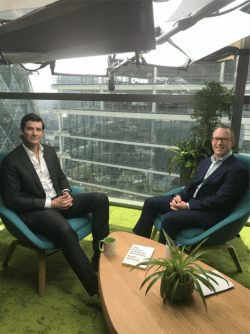How To Gain Consumer Trust in Today’s World
By Simon Mulcahy, Chief Innovation Officer, Salesforce
Throughout history, cultures and social revolutions have been influenced by new “technologies.”
- In the 16th and 17th century Britain, coffee houses were banned by royal decree due to the social implications of consuming a substance outside of the home.
- At the start of the 20th century, Henry Ford revolutionised car production.
- Nowadays, we live in a world of digital and social media where a brand is no longer defined by its products and proclamations but more so by the sum of their customers’ conversations about it. In many ways, this means that trust gets driven more by a brand’s community than by the brand itself.
Trust is the number one issue plaguing businesses today and a hot-button topic in social, political, and economic circles.

In fact, 95% of customers say they’re loyal to companies they trust even though 54% don’t believe companies have their best interests in mind, according to the State of the Connected Customer report by Salesforce.
We have great privilege — and great responsibility — to live in a time when technology is rapidly changing the world. Now, it’s time for massive change to happen around the subject of trust.
I recently sat down with Nicholas Davis, Head of Society and Innovation at the World Economic Forum, to discuss the Fourth Industrial Revolution (4IR) — the fourth major industrial era characterised by the fusion of digital, physical, and biological technologies — and its implications on customer trust.
The State of Trust
We don’t just choose our favourite products, we now become loyal to entire brands. Consumers have the tools to amplify their opinions via social media and review sites, which can oftentimes be seen as creating a huge risk for brands. At any given time, an unhappy customer can tarnish a brand with their feedback.
“At the same time we’re giving away data through mobile devices, we’re also demanding that someone —the government or companies — do something about it because we know the benefits and yet have trust issues in what is happening behind the scenes,” says Davis.
Is it possible to spearhead a positive consumer trust revolution for your brand? It may be as easy as starting the conversation.
4 Ways Brands Can Bridge the Trust Gap
1. Tell consumers exactly how you use their data and for what purpose.
Consumers are willing to share their data in exchange for more personalised experiences — as long as they understand how and why. It’s important to be upfront with customers on an annual or more frequent basis: “Here’s the data we have about you. In exchange for sharing it, here’s how we’re using it to improve your experiences, send you more relevant promotions, and lower your costs.”
2. Use CEO influence to gain consumer trust for your brand.
While consumer trust is lacking in some industries, Edelman reports that 40% of people do trust CEOs (which is much higher than you might expect). CEOs have a unique opportunity — and a position of power — to influence customers to trust more in the brands they regularly interact with.
Not only can CEOs be more present in brand communications to help build this level of trust, but they can also lead discussions around trust and help influence policy to advance the “positive trust revolution.”
3. Avoid “quick fixes” by listening.
It’s tempting to just place a bandage over the trust issues plaguing businesses by hiring a chief trust officer or investing in an ad campaign that essentially says your business is being proactive around trust.
A better way for brands to do this is by building a network of industry and community members to bring multiple perspectives to the broader discussion.
Talk to unions. Bring in the NGO community. Doing so will help you see consumers less as a series of transactions and more like partners in building trust.
“Beyond talking, another vital way we build trust is by listening,” says David Schmaier, CEO of Vlocity, a cloud app adoption company that helps extend the power of Salesforce.
“Listening, as we all know, is a basic element of conversing, yet fewer and fewer companies seem to be listening to what customers have to say about their needs and expectations.”
4. Put values and ethics at the heart of your business model.
Truly exercising your company values means more than just posting your company’s core beliefs to your website. It means orienting your entire business around a particular goal or ethos. The ride-sharing industry is one that’s gone from risk and skepticism to being socially-accepted in just the last decade.
Turning the Crisis into Opportunity
This trust gap that we’re experiencing now is actually a huge opportunity for brands. With emerging technologies like artificial intelligence (AI) still in their infancy, business leaders have the power to influence policy around how they develop, invest in, and deploy more personalised and intelligent tech. More than anything else, they must think about how innovation can create trusted relationships that advance their brand’s mission.
“With ubiquitous connectivity for the lucky four billion people who are connected around the world, we have a different set of challenges. We have the challenges to democracy, to community, and to identity. And so, we need new ways of continuing to fight the trust battle,” says Davis.
Article first appeared on the Salesforce blog.
Lava is an authorised Salesforce Partner in Malaysia and has more than a decade of experience in cloud solutions which includes marketing automation, CRM implementation, change management, and consultation. We pride ourselves in not just being a CRM partner but in also understanding the needs of our customers and taking their business to the next level.

